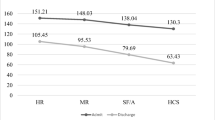Abstract
Homogeneity and other characteristics of rural community mental health center adult, outpatient dropouts were investigated with particular attention to length of stay. Analyses of 93 cases during a one year period revealed that qualities of the therapist discriminated short-term dropouts from long-term dropouts and longterm terminators. The client's chronicity discriminated short-term dropouts from shortterm terminators. Dropouts were not found to be a homogeneous group. While therapist characteristics may be important in predicting termination status in long-term stays, the termination status of short-term clients may be determined primarily by the severity of the client's problems and whether or not they have received previous treatment.
Similar content being viewed by others
References
Albers, R.J., & Scrivner, L.L. The structure of attrition during appraisal.Community Mental Health Journal, 1977,13, 325–332.
Baekeland, F., & Lundwall, L. Dropping out of treatment: A critical review.Psychological Bulletin, 1975,82, 738–783.
Bowden, C.L., Schoenfeld, L.S., & Adams, R.L. A correlation between dropout status and improvement in a psychiatric clinic.Hospital & Community Psychiatry, 1980,31, 192–195.
Brandt, L.W. Studies of “dropout” patients in psychotherapy: A review of findings.Psychotherapy: Theory, Research & Practice, 1965,2, 2–13.
Carpenter, P.J., Del Gaudio, A. C., & Morrow, G.R. Dropouts and terminators from a community mental health center: Their use of other psychiatric services.Psychiatric Quarterly, 1979,51, 271–279.
Cartwright, R., Lloyd, S., & Wicklund, J. Identifying early dropouts from psychotherapy.Psychotherapy: Theory, Research & Practice, 1980,17, 263–267.
Dowell, D.A., & Ciarlo, J. A. Overview of the Community Mental Health Centers Program from an evaluation perspective.Community Mental Health Journal, 1983,19, 95–125.
Duehn, W. D., & Proctor, E.K. Initial clinical interaction and premature discontinuance in treatment.American Journal of Orthopsychiatry, 1977,47, 284–290.
Epperson, D.L., Bushway, D.J., & Warman, R.E. Client self-termination after one counseling session: effects of problem recognition, counselor gender, and counselor experience.Journal of Counseling Psychology, 1983,30, 307–315.
Ersner-Hershfield S., Abramowitz, S.I., & Baren, J. Incentive effects of choosing a therapist.Journal of Clinical Psychology, 1979,35, 404–406.
Fiester, A.R., Mahrer, A.R., Giambra, L.M., & Ormiston, D.W. Shaping a clinic population: The dropout problem reconsidered.Community Mental Health Journal 1974,10, 173–179.
Fiester, A.R., & Rudestam, K.E. A multivariate analysis of the early dropout process.Journal of Consulting and Clinical Psychology, 1975,4, 528–535.
Folkins, C., Hersch, P., & Dahlen, D. Waiting time and no-show rate in a community mental health center.American Journal of Community Psychology, 1980,8, 121–123.
Garfield, S.L. Research on client variables in psychotherapy. In S.L. Garfield and A.E. Bergin (Eds.),Handbook of Psychotherapy and Behavior Change: An Empirical Analysis (2nd ed.). New York: John Wiley & Sons, 1978.
Gottschalk, L.A., Mayerson, P., & Gottlieb, A.A. Prediction and evaluation of outcome in an emergency brief psychotherapy clinic.The Journal of Nervous and Mental Disease, 1964,144, 77–96.
Hoen-Saric, R., Imber, F.J., Nash, S., Stone, E., & Battle, M. Systematic preparation of patients for psychotherapy. I. Effects on therapy behavior and outcome.Journal of Psychiatric Research, 1964,2, 267–281.
Kerlinger, F.N. & Pedhazur, E.J.Multiple Regression in Behavioral Research. New York: Holt, Rinehart and Winston, 1973.
Kline, J., & King, M. Treatment dropouts from a community mental health center.Community Mental Health Journal, 1973,9, 491–498.
Littlepage, G.E., Kosloski, K.D., Schnelle, J.F., McNees, M.P., & Gendrich, J.C. The problem of early outpatient terminations from community mental health centers: A problem for whom?Journal of Community Psychology, 1976,4, 164–167.
Morrow, G.R., Del Gaudio, A.C., & Carpenter, P.J. The dropout and the terminator: A methodological note on definitions.Journal of Clinical Psychology, 1977,33, 867–869.
Orne, M., & Wender, P. Anticipatory socialization for psychotherapy: Method and rationale.American Journal of Psychiatry, 1968,124, 1202–1212.
Pekarik, G. Follow-up adjustment of outpatient dropouts.American Journal of Orthopsychiatry, 1983,53, 501–511.
Pekarik, G. Coping with dropouts.Professional Psychology: Research and Practice, 1985a,16, 114–123.
Pekarik, G. The effects of employing different termination classification criteria in dropout research.Psychotherapy, 1985b,22, 86–91.
Philips, E.L., Raiford, A., & Rutledge, V. Attrition: A perplexing clinical problem.Psychological Reports, 1967,20, 26.
Reder, P., & Tyson, R.L. Patient droupout from individual psychotherapy.Bulletin of the Menninger Clinic, 1980,44, 229–252.
Rockwell, W.J.K., & Pinkerton, R.S. Single-session psychotherapy.American Journal of Psychotherapy, 1982,36, 32–40.
Silverman, W.H., & Beech, R.P. Are dropouts, dropouts?Journal of Community Psychology, 1979,7, 236–242.
Straker, M. Brief psychotherapy in an outpatient clinic: Evolution and evaluation.American Journal of Psychiatry, 1968,124, 1219–1225.
Sue, S., McKinney, H. L., & Allen, D.B. Predictors of the duration of therapy for clients in the community mental health system.Community Mental Health Journal 1976,12, 365–375.
Tantam, D., & Klerman, G. Patient transfer from one clinician to another and dropping-out of out-patient treatment.Social Psychiatry, 1979,14, 107–113.
Warren, N.C. & Rice, L. Structure and stabilizing of psychotherapy for low-prognosis clients.Journal of Consulting and Clinical Psychology, 1972,39, 173–181.
Author information
Authors and Affiliations
Rights and permissions
About this article
Cite this article
Tutin, J. A multivariate analysis of dropout status by length of stay in a rural community mental health center. Community Ment Health J 23, 40–52 (1987). https://doi.org/10.1007/BF00752823
Issue Date:
DOI: https://doi.org/10.1007/BF00752823



